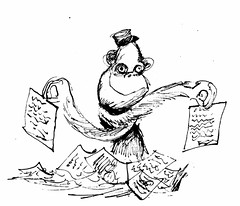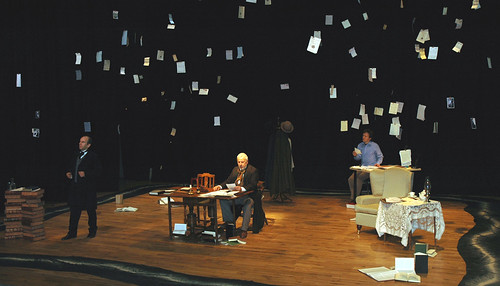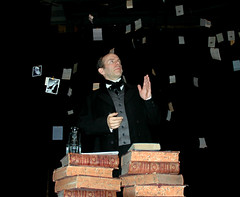Background
Re:Design is an extraordinary new play based on the letters of Charles Darwin.
Written by editing exclusive material from the Darwin Correspondence archive at Cambridge University, the play includes many letters not yet in the public domain. Entirely verbatim, the play focuses on the correspondence between Darwin and Professor Asa Gray of Harvard, but also includes many other letters and published and private thoughts from friends, family, colleagues and rivals, as Darwin and Gray investigate and debate the arguments around science and religion in particular, but also their varied interests in science and society in general. This professional play is produced by Menagerie, one of the UK’s best touring theatre companies, on two scales – a simple small one for schools and colleges, and a full scale production for events, conferences and theatre runs. Starring Terry Molloy as Darwin, the play is written by Craig Baxter and directed by Paul Bourne. It is available for UK and international touring throughout 2009.
GRAY: “Organic Nature abounds with unmistakable and irresistible indications of design.”
DARWIN: “Can the mind of man, which has, as I fully believe, been developed from a mind as low as that possessed by the lowest animal, be trusted when it draws such grand conclusions?”
With The Atlantic Ocean between them, Charles Darwin in England, and Asa Gray at Harvard, correspond voraciously in an attempt to reconcile orthodox Christian beliefs with Darwin’s new theory of evolution by natural selection. Using only their own words, we enter the worlds of these groundbreaking 19th century naturalists as they debate the great issues of science and religion whilst sharing news of personal tragedies and triumphs, holiday experiences and various gardening accidents! .

Thoughts and point of departure…
“. . . the Intelligent Design movement as well as those opposed to the ID approach need to examine and learn the history of Natural Theology and design, reading both the advocates and the opponents. . . . we can follow the pattern of civility and humility that both Gray and Darwin displayed as they sought to understand each other’s position, to acknowledge strengths in argumentation and to point out weaknesses in reasoning. . . Their letters were filled with words like “dear” and “friend,” and signed with such words as “cordially” and “affectionately.” Differences of opinion–clearly and forcefully stated–did not distort or disrupt their relationship. Gray’s testimony was respected by Darwin, and Darwin’s real confusion was accepted by Gray. They continued to reach out to each other, and their relationship actually served as a bridge that each could cross in their journey toward Truth. We could do worse than emulate their pattern of debating vigorously yet loving genuinely as we interact with one another on this subject that has yet to be fully resolved.”
Sara Joan Miles, Charles Darwin and Asa Gray discuss teleology and design.
The vigorous and yet civil and humble manner in which the two men debated matters of intense personal belief and social consequence should serve a model of constructive engagement for the present. It also makes fascinating theatre…
Background
 The longest running and most intimate exchange of letters that Darwin had about the relationship between science and religion was with the Harvard botanist and devout Christian Asa Gray. This correspondence, consisting of about 300 letters has now been turned into a play by British playwright Craig Baxter.
The longest running and most intimate exchange of letters that Darwin had about the relationship between science and religion was with the Harvard botanist and devout Christian Asa Gray. This correspondence, consisting of about 300 letters has now been turned into a play by British playwright Craig Baxter.
Commissioned by The Darwin Correspondence Project at Cambridge University, this new production has been created by professional theatre company Menagerie of Cambridge, England. The play was premiered in its showcase form during Cambridge University Science week on 25th March 2007.
It features the personal thoughts sent in correspondence between Charles Darwin and American botanist Asa Gray, along with those of other contemporaries and members of the Gray/Darwin families.
The play is developed in ‘verbatim style’ using only the words as written by the principal characters. Many of the letters used in developing this piece will be aired for the first time as they are not currently available to the public.
The theatrical realisation of RE: Design is compelling not only because we hear the words of these great men, but also because the dramatic form employed plays with time and space to gain an intimacy into issues and arguments that are still resonant today.

The raw material is the correspondence exchanged by Charles Darwin and Asa Gray over the period 1854 to 1881, with additional letters exchanged between them and their mutual friend Joseph Dalton Hooker. The piece will use only their own words to chronicle their relationship, with particular reference to their intimate discussions of the implications of their scientific work for their personal beliefs and for religious belief in general.
Darwin and his correspondents were very human. They had ambitions, anxieties, religious and political beliefs, health problems, enthusiasms, faith, doubt, desires and obsessions. They were social animals, members of families and institutions, with acute awareness of status, decorum, gentlemanliness, and honour. RE: Design brings this human and social context to life.

Because drama is a medium of empathy, it can help us feel a little of what it must have been like to be Charles Darwin or Asa Gray or Joseph Hooker. You see a man reporting the results of an experiment while at the same time mourning the death of his child; you see a man falling over backwards to pay a compliment while begging for yet another favour; you see people exchanging information, laughing at themselves and sharing one another’s tragedies and triumphs. This empathic insight is a complement to scholarly study, and adds to its understanding. This production is highly insightful as well as entertaining and moving.



